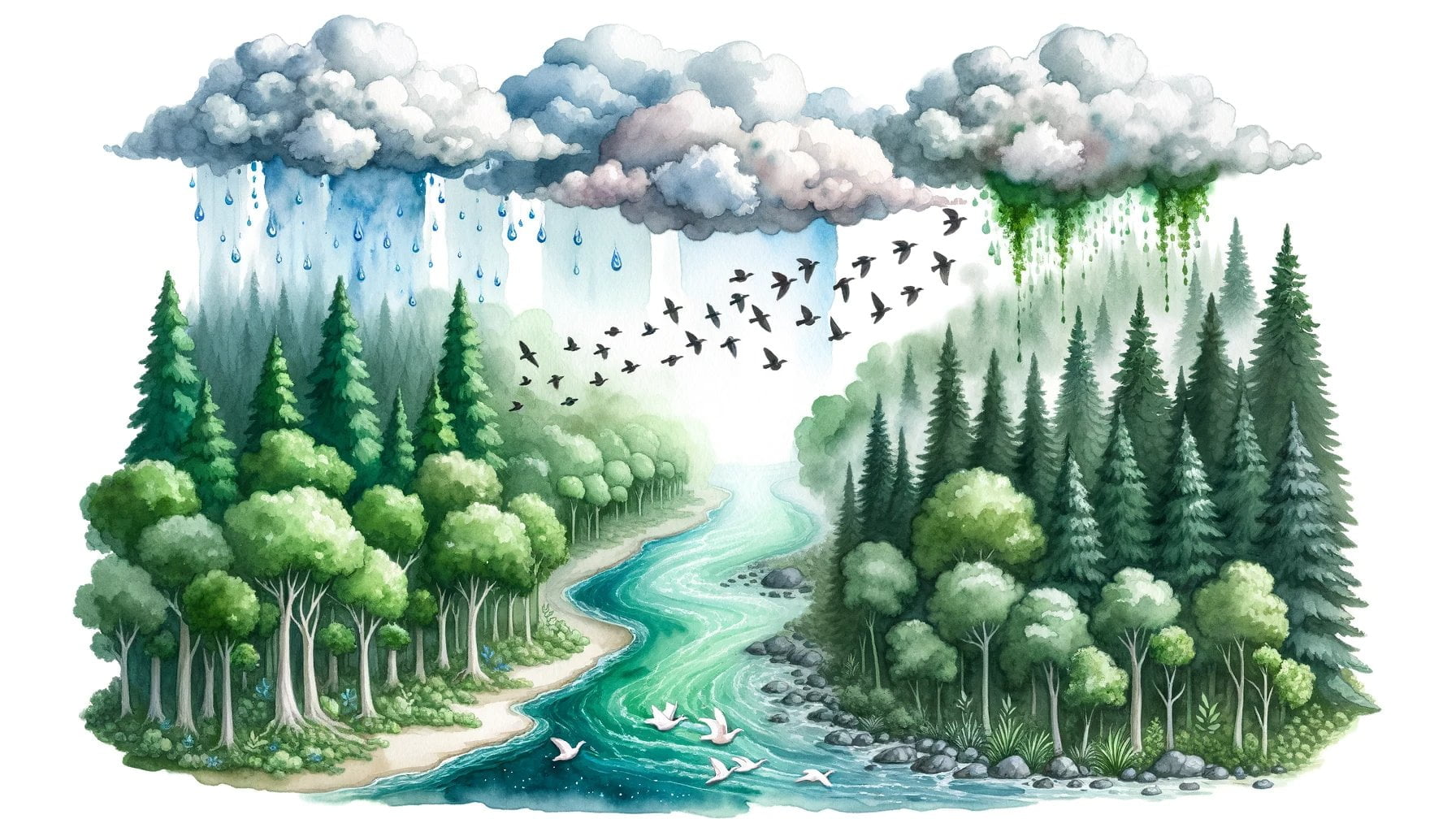Transpiration, a crucial process in the intricate workings of the water cycle, plays a significant role in maintaining Earth’s equilibrium and sustaining life as we know it. In this article, we will delve into the definition of transpiration, its importance in the water cycle, and the various variables that affect transpiration rates. As we explore the complex interplay between plant physiology, climate patterns, and soil moisture dynamics, we aim to enlighten readers about the significance of transpiration in shaping regional water resources and climate systems.
Transpiration Water Cycle
Transpiration, a crucial process in the water cycle, plays a significant role in maintaining Earth’s equilibrium and sustaining life as we know it. In this article, we will delve into the intricacies of transpiration and explore how it contributes to the movement of water throughout the planet.
What is Transpiration?
Transpiration is the process through which water vapor is released into the atmosphere from plants and soil. It is a fundamental part of the water cycle, which describes how water moves and circulates on Earth.
How does Transpiration work?
Water is transported through a plant’s roots to its leaves, undergoing various processes until it changes into vapor and is released into the air. This transformation happens through microscopic pores on the surfaces of leaves, known as stomata. These tiny openings allow water vapor to escape into the atmosphere.
Why is Transpiration important?
Transpiration plays a crucial role in maintaining moisture conditions in the environment. By releasing water vapor, plants help regulate humidity levels, which are essential for various ecological processes. Additionally, transpiration contributes to the cooling of leaves and the surrounding environment, similar to how sweating cools our bodies.
The Significance of Transpiration in the Water Cycle
Transpiration accounts for a substantial amount of moisture in the Earth’s atmosphere. Approximately 10 percent of atmospheric moisture is a result of water transpired by plants. This water vapor eventually condenses and forms clouds, leading to precipitation. This precipitation replenishes the Earth’s water sources, such as rivers, lakes, and groundwater, continuing the water cycle.
Factors Affecting Transpiration
Several factors influence the rate of transpiration. Light intensity, temperature, humidity, and wind speed all impact the amount of water vapor released by plants. In general, higher light intensity and temperature increase the rate of transpiration, while higher humidity reduces the rate. Wind speed can influence transpiration by facilitating the movement of water vapor away from the leaves.
To summarize, transpiration is a vital process in the water cycle. It helps regulate moisture conditions, cools the environment, and contributes to the replenishment of water sources. By understanding the significance of transpiration, we can appreciate the intricate workings of the water cycle and the crucial role it plays in maintaining Earth’s equilibrium.
Transpiration is a key process in the water cycle, and understanding its mechanism is crucial. Have you ever wondered what cycle transpiration is from plants? Click here to learn more about the cycle of transpiration from plants. Additionally, the water cycle consists of four stages, which are essential for the Earth’s water supply. Curious about what these stages are? Discover the answer here and delve into the intricacies of the water cycle.
Transpiration itself serves an important function in the survival of plants. Want to know more about its purpose and how it aids in the various physiological processes of plants? Find out by clicking here. One might question whether water is released during transpiration. To find the answer, explore this compelling aspect by accessing the link here.
The process of transpiration is fascinating yet complex. How does it occur within plants? Uncover the details by clicking on the link here. Additionally, have you ever wondered why transpiration occurs? The answer to this intriguing question is just a click away here.
Plants rely on transpiration to provide water in their systems. Curious about why they do so? Click here to learn about the reasons behind this vital mechanism. Furthermore, delve into the depths of how transpiration precisely provides water in plants by clicking here.
Transpiration predominantly occurs in specific areas of plants, but where exactly does this water loss take place? Explore the locations and details of transpiration by following the link here. These captivating insights into the world of transpiration within the water cycle are sure to leave you with a newfound appreciation for the processes that sustain our environment.
Importance Of Transpiration Water Cycle
Transpiration is a fundamental process in the water cycle, playing a vital role in maintaining Earth’s equilibrium and sustaining life as we know it. Let’s dive into the significance of transpiration and explore how it influences the water cycle.
A Crucial Transportation System
One of the key functions of transpiration is its role in the conduction of water and minerals within plants. Through this process, water and essential nutrients are transported from the roots to different parts of the plant, nourishing and supporting its growth. Imagine transpiration as a complex transportation system, efficiently delivering vital resources to every cell of the plant.
Transpiration enables plants to transport water and minerals, supporting their growth and development.
Maintaining Water Balance
Maintaining a balance of water within plants is essential for their overall functioning and health. Transpiration plays a critical role in this aspect, as it continuously eliminates water from the plant’s body. By releasing water through microscopic pores called stomata, plants are able to maintain a balance between water uptake and loss. This regulation ensures that the plant’s cells are properly hydrated and functioning optimally.
Transpiration helps plants maintain a healthy water balance, ensuring their overall well-being and functionality.
Osmosis and Cell Rigidity
Transpiration also impacts the process of osmosis, which is the movement of water through a selectively permeable membrane. As water is lost through transpiration, it helps maintain the rigidity of plant cells by preventing excessive water uptake. This rigidity is essential for maintaining the structural integrity and functionality of plant tissues.
Transpiration aids in keeping plant cells rigid, supporting their structure and optimal function.
Releasing Water Vapor
When we think of transpiration, we often associate it with the release of water vapor into the atmosphere. Plants release water vapor through the stomata, contributing to the overall water content in the atmosphere. This process is not only associated with the sun and evaporation, but it also plays a crucial role in regulating the moisture levels in the surrounding environment.
Transpiration releases water vapor into the atmosphere, contributing to moisture regulation and the overall water cycle.
Removing Excess Water
While plants absorb water from the soil, not all of it is used for growth and metabolic processes. Transpiration helps plants get rid of this excess water by evaporating it through the stomata. By eliminating excess water, transpiration ensures that only the necessary amount of water is retained within the plant, optimizing its overall performance.
Transpiration eliminates excess water, allowing the plant to maintain an optimal water content for growth and metabolism.
Regulating Moisture Conditions
Transpiration plays a vital role in maintaining moisture conditions in the environment. Approximately 10 percent of the moisture in the Earth’s atmosphere is a result of transpiration by plants. This moisture helps regulate humidity levels and contributes to the overall water cycle. Think of transpiration as a natural humidity regulator, ensuring the appropriate moisture balance in our surroundings.
Transpiration is essential for regulating moisture conditions, contributing to overall humidity levels and the water cycle.
In conclusion, transpiration is of utmost importance in the water cycle. It facilitates the conduction of water and minerals, helps maintain a balance of water within plants, supports osmosis and cell rigidity, releases water vapor into the atmosphere, removes excess water, and regulates moisture conditions in the environment. Understanding the pivotal role of transpiration allows us to appreciate its significance in sustaining life on our planet.
Variables Affecting Transpiration Rates
Transpiration, the process by which plants release water vapor into the atmosphere, is vital for maintaining Earth’s water cycle and supporting life as we know it. To better understand the complexity of this process, it is crucial to explore the various factors that influence the rate at which transpiration occurs in plants. In this article, we will delve into the key variables that affect transpiration rates and their significance in the larger context of the water cycle.
Temperature: One of the primary factors influencing transpiration rates is temperature. As temperature rises, so does the rate of transpiration. This correlation can be attributed to increased kinetic energy within plant cells, stimulating the movement of water molecules and facilitating their release through the stomata. Higher temperatures not only intensify water evaporation from the plant’s surface but also contribute to an increased vapor pressure gradient, further promoting the transpiration process.
Quote: “Temperature plays a significant role in determining transpiration rates, with higher temperatures resulting in increased water loss from plants.”
Wind Speed: Another crucial variable affecting transpiration rates is wind speed. Wind promotes transpiration by removing water vapor from the surface of leaves, thereby increasing the water vapor pressure gradient. When wind blows across the stomata, it effectively replaces the humid air around the plant with drier air, creating a more conducive environment for water evaporation. Consequently, higher wind speeds lead to enhanced transpiration rates.
Quote: “The speed at which wind moves influences transpiration rates, with higher wind speeds facilitating greater water loss from plants.”
Humidity: Humidity, defined as the amount of moisture in the air, also plays a significant role in regulating transpiration rates. Elevated humidity levels decrease the rate of transpiration. This occurs because of the reduction in the vapor pressure gradient between the moist air surrounding the leaves and the atmosphere. With higher humidity, the atmosphere becomes less capable of absorbing additional water vapor, resulting in a decreased transpiration rate.
Quote: “High humidity levels can significantly reduce transpiration rates, as the moisture-saturated air limits the amount of water vapor plants can release.”
Light: The availability and intensity of light directly influence the rate of transpiration. Light plays a crucial role in promoting the opening of stomata, small pores on the surface of leaves responsible for water vapor release. When exposed to light, plants undergo a process called photosynthesis, converting light energy into chemical energy. In order to facilitate this process, stomata open to allow for gas exchange, including water vapor release. Therefore, increased light intensity leads to a higher rate of transpiration.
Quote: “Light acts as a catalyst for transpiration, with increased light intensity promoting stomatal opening and enhancing the release of water vapor.”
Atmospheric Pressure: Atmospheric pressure also affects the rate of transpiration. Changes in atmospheric pressure can impact the vapor pressure gradient, which drives the movement of water vapor from the plant to the surrounding atmosphere. When atmospheric pressure is high, the gradient is reduced, resulting in a decrease in transpiration rates. Conversely, lower atmospheric pressure creates a more favorable gradient, facilitating higher rates of transpiration.
Quote: “Atmospheric pressure has a direct influence on transpiration rates, with higher pressure impeding the release of water vapor and lower pressure promoting it.”
Available Soil Water: The availability of soil water is a crucial factor in determining transpiration rates. When soil moisture levels are low, plants experience water stress, resulting in the closure of stomata to minimize water loss. This adaptive response reduces transpiration rates, as plants strive to conserve water during periods of limited availability. Conversely, in well-hydrated soils, plants have a greater water supply, allowing for increased transpiration rates.
Quote: “The availability of soil water directly impacts transpiration rates, with water-stressed plants reducing water loss to conserve resources.”
Understanding these variables and their impact on transpiration rates provides valuable insights into plant physiology and water usage in ecosystems. By unraveling the intricate workings of transpiration, we can gain a deeper appreciation for its role in maintaining Earth’s equilibrium and sustaining life. So, let us continue our exploration of the water cycle and the significance of transpiration in our world.
Condensation, a fascinating phenomenon in the water cycle, can amaze us with its intricate process and intriguing Fun Facts. Did you know that condensation is the transformation of water vapor into liquid water droplets? Learn more about it on Lola App’s intriguing webpage on Fun Facts About Condensation in the Water Cycle. While condensation may seem like a simple concept, this article delves into the science behind it, providing a deeper understanding of how water transforms its state. Visit this link to explore the captivating world of condensation.
FAQ
Question 1: What is transpiration in the water cycle?
Answer: Transpiration is the process of water vapor being released from plants and soil into the atmosphere. It is part of the water cycle, which describes how water moves throughout the Earth.
Question 2: Why is transpiration important?
Answer: Transpiration plays a crucial role in maintaining moisture conditions in the environment. It helps regulate humidity levels and contributes to the overall water cycle. Additionally, transpiration helps in the conduction of water and minerals, maintaining water balance within plants, supporting osmosis and cell rigidity, releasing water vapor, and removing excess water.
Question 3: How does temperature affect transpiration rates?
Answer: An increase in temperature generally increases the rate of transpiration. This is because higher temperatures cause the stomata, microscopic pores on plant leaves, to open wider, allowing for more water vapor to be released.
Question 4: What factors affect the rate of transpiration?
Answer: Several factors can affect the rate of transpiration, including wind speed, humidity, light, atmospheric pressure, and the availability of soil water. Wind speed increases transpiration, while high humidity decreases it. Light promotes the opening of stomata, thus increasing transpiration. Atmospheric pressure and the availability of soil water also play a role in determining the rate of transpiration.
Question 5: How much moisture in the Earth’s atmosphere is from transpiration?
Answer: As much as 10 percent of the moisture in the Earth’s atmosphere is from transpiration by plants. This highlights the significant contribution of transpiration to the overall water cycle and moisture regulation in the environment.
- Sept 31 Myth: Unveiling Calendar Secrets - March 18, 2025
- How Long & Till December 18, 2025: Accurate Countdown Guide - March 18, 2025
- Discover Japanese Artists: A Complete History - March 18, 2025


















